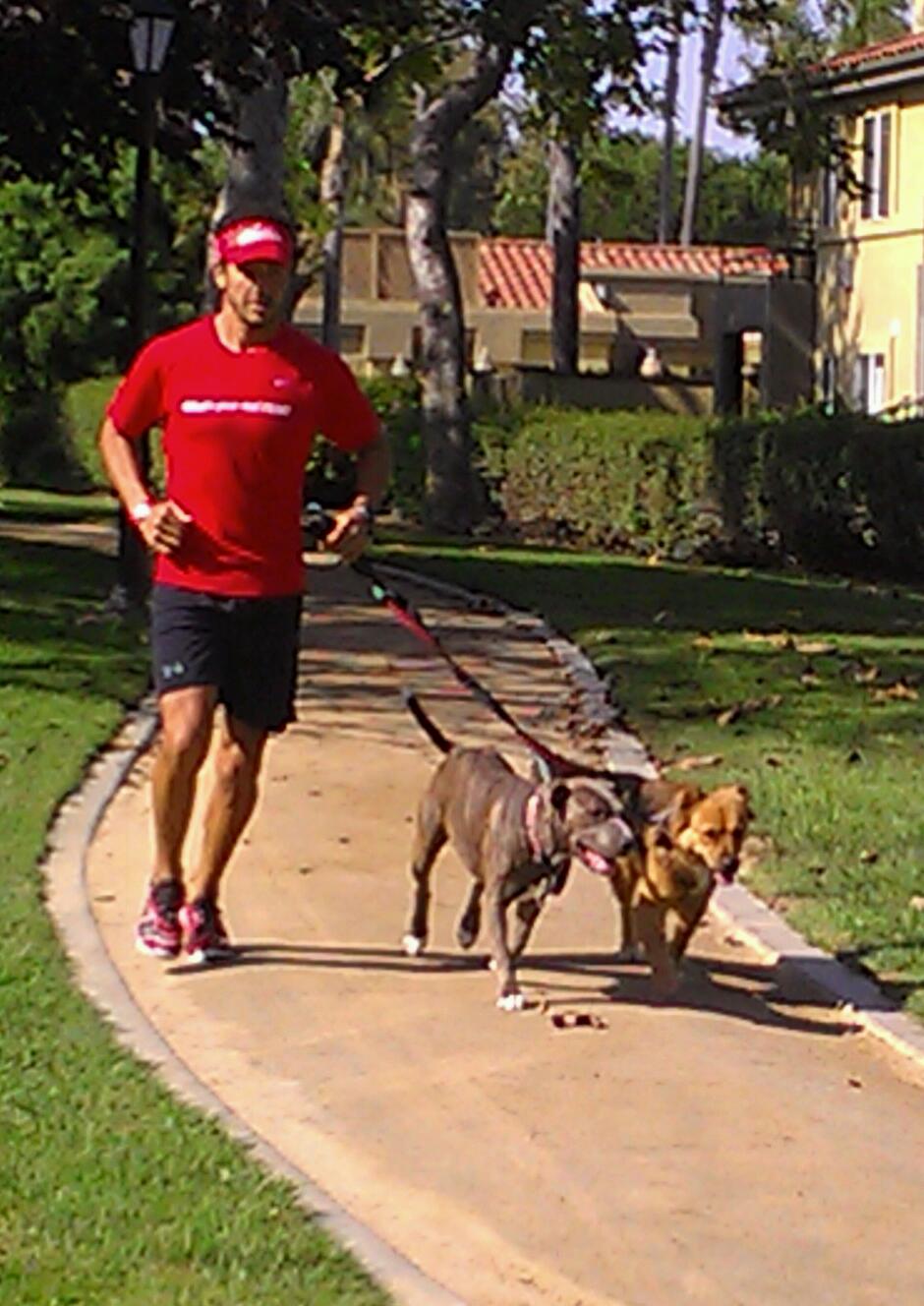
Bridging the gap between your love for running and your love for your dog.
So you’re a runner and you love dogs. That most likely means you are awesome! But seriously … running is what gives you your natural high, and running is what your dog fiends and was built to do. So it seems like a no brainer—bridge the gap between your love for the road and your love for your pooch. But not so fast … maybe you’ve tried this before, only for it to end in a leash-tangled mess of frustration!
Running with your dog can be a very rewarding experience and foster an even deeper bond between the both of you. When done safely and effectively, it can also provide a necessary outlet of energy for your dog which can help maintain a healthy weight, promote a longer more active life, and in some cases, even help correct problem behaviors.
The following tips can help you find your “fit” with your dog through running:
- Choose the right the dog for the type of running companion you are looking for. An ultra marathoner shouldn’t expect a pug to hammer out 15 milers with them. For a break down on which dogs are best for which running conditions and distances, check out this great article from Runner’s World: http://www.runnersworld.com/
article/0,7120,s6-238-527– 13611-0,00.html - Work on leash walking first. Obviously a dog that doesn’t understand or do well with the concept of walking on a leash is going to be a handful when trying to run with you. Baby steps … start from the bottom and build up.
- Ease into the run. Let your canine companion get all of his/her sniffing and “relievings” out of the way first. Start with a 5-10 minute walk rather than just jumping into the run. This is good advice for humans too, by the way!
- Practice proper leash technique. There should be very little to no tension in the leash when your dog is running with you. In the beginning, you may want to use the two hand method for holding the leash, keeping fido even with you at your side rather than in front of you pulling. If you find that the reverse is happening and you are the one doing the pulling, then it’s most likely one of two things: 1) your pooch is exhausted, or 2) you have an uncertain, scared pup. The answer is obvious with #1. With #2, stop, and walk until your dog gains confidence and begins walking at your side. Slowly work back into the jog, repeating this process as necessary.
- Avoid long runs on hard surfaces. Avoid concrete when possible. Grass and dirt is always best. Be sure your dogs’ nails are at a proper length so as not to adversely affect running mechanics.
- Beat the heat! Imagine running barefoot on a scorching hot surface for miles. Sounds awful right? Don’t do this to your dog! Pads can easily burn and blister on blacktop and concrete if you run your dog in the heat of the day. Not to mention the risk for heat exhaustion. Also remember that your dog can’t sweat, meaning he/she can’t dissipate heat as efficiently as you can. Their only hope to thermoregulate is to pant. If your dog’s tongue is very large and your dog is panting rapidly and shallowly, these are warning signs that over heating may be just around the corner. Find some shade and some water immediately. Rubbing water on your dogs belly skin can help dissipate some heat. Use common sense here—when running longer distances in warmer conditions, plan ahead and have water with you or choose a route with water stations. In the end, the best advice would be to get out early or leave fido at home.
- Increase mileage gradually, and beware of signs that your dog is fatigued. Dogs aim to please their masters, and when they are slowing down toward the later stages of a run, it generally means they are physiologically exhausted. This is where you as a loving dog owner may need to put the rest of your workout on hold and walk your dog the rest of the way. As a running coach for humans, I seldom increase a person’s distance by more than 10% per week. I’ve found the same rule can be applied to dogs. Don’t forget to periodically check on your dog during the run. Watch for changes in gait pattern, a hanging head and a large tongue. Listen for gasping and wheezing as well. Runs with your dog are a good time to leave the head phones at home.
- Has your dog been cleared?? Humans get physical exams and are cleared to exercise by their doctor. Do your pooch the same service by having them regularly checked by a veterinarian to ensure they are healthy and able to undergo more strenuous exercise.
The Take Home Point …
Be patient, particularly in the beginning. Let me tell you my story (don’t worry, I’ll be quick!). I went from a well-trained chocolate lab (the quintessential mid-distance running buddy in my book), to a blind pittie puppy (four words for you … all over the place!). In the beginning, little Stevie (the pittie) was spastic. Because she’s mostly blind, she can often over-respond to the gazillion smells and sounds that constantly bombard her. Couple that with some big human guy pulling her around on a leash for the first time, the uncertainty she felt in each step she took, and you could imagine the frustration that began to mount–for both of us. It made me really miss my old chocolate lab (“Sage the queen”, who passed after a solid 15 years). But I found that the more I got annoyed, the worst things got. On the other hand, the more I relaxed and went with it (which meant ditching a prescribed run to simply walk at times), the more things vastly improved. The take home point? Make it a positive experience for your dog no matter what, and in time he/she will cruise along your side with tongue flapping through a great big smile. If you’re a competitive runner, I wouldn’t recommend taking your dog with you on a key training day, at least in the beginning. If you do, be prepared to scrap your workout if need be!
Hope these tips help. Here’s to finding your “Fit” with Fido!!
Cheers,
PEAKFINDERS Training
What’s Your Real PEAK?
Chris Heslin is triathlete/runner and the founder of PEAKFINDERS Training (www.peakfinderstraining.com), an organization that trains people to be fit and at the same time helps to raise money for The Barking Lot. He is also a Barking Lot volunteer, and loves running with his TBL alums, Stevie and Josie.














If you want to take this to the next level, check out Running with Dogs: Dog-Friendly Races in the USA — http://www.amazon.com/dp/B00CA5082I (You don’t need a Kindle device to read it.)